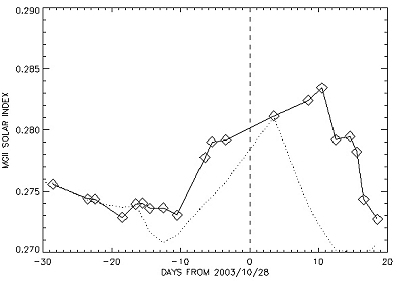SWAN observes fading sunspots on the back side of the Sun
19 November 2003
The new Lyman-alpha method to monitor the activity of sunspots when they are on the far side of the Sun has been recently applied to a duo of giant sunspots number 486 and 488. The SWAN team (Jean-Loup Bertaux and Eric Quemerais) has found that their activity has decreased significantly in the last few days.These giant active regions were facing the Earth around October 28, when an intense Coronal Mass Ejection (CME) sent giant clouds of energetic particles (protons) out into the solar system. This affected many spacecraft, including the Mars Express ESA mission currently cruising towards Mars, for an encounter on 25 December.
Star trackers on the Mars Express spacecraft could not be used for a period of time because of the effect of these high energy protons, accelerated in the shock front produced when the fast solar wind plasma of the CME bumps into the standard slower solar wind. Instead of identifying some stars in the field of view of the star tracker (which can be viewed as quite similar to a standard digital camera with a so-called CCD detector), the images are looking more like a heavy snowstorm.
Mars Express survived this intense episode of solar activity easily, but there was some concern about the possible repetition of such an event, when the same sunspots 486 and 488 would come around on the Sun's east limb to face the Earth and Mars Express again. Due to the 27 days solar rotation, the two sunspots disappeared from direct view around November 4, and are reappearing today on the east limb of the Sun.
Observing the far side of the Sun with SWAN
SWAN - short for Solar Wind Anisotropies - can indirectly monitor the activity on the far side of the Sun by mapping the whole sky in ultraviolet light. A huge cloud of interstellar hydrogen that bathes the entire Solar System interacts with the solar wind, and lights up in Lyman-alpha emission when it is hit by UV radiation from the Sun. Since active regions on the Sun are brighter in Lyman-alpha light, the sky displays more intensity in the region facing them, like a rotating lighthouse beam. Any change in the solar activity is in this way directly reflected in the amount of Lyman-alpha emission that is observed by SWAN.
SWAN sees decreasing activity
During the whole period after 28 October, SWAN was put in a more than usual intensive mode of monitoring solar activity on the far side of the Sun. A series of maps of the full sky were obtained in the UV. A quantitative analysis of the Lyman-alpha brightness of the active region is given in relation to the classical magnesium index (MgII index), which can be measured only from Earth. The MgII index has a typical value of 0.265 for low solar activity, reaching 0.288 for highest solar activity. On October 28, it had a value of 0.280.
Using SWAN data scientists can measure what the evolution of this MgII index would be for an observer rotating with the Sun, who would always face the active region during the solar rotation. The MgII index found by SWAN was still increasing after October 28 up to the peak value of 0.283, which was reached on November 7. Since then it has been rapidly decreasing down to 0.273 on November 15.
The corresponding decrease of the solar Lyman-alpha brightness found by SWAN was 20%. This is the sign that the activity of the two sunspots 486 and 488 has significantly decreased since their maximum value, reducing also (but not to zero) the probability of a new episode of solar storm as the one experienced on October 28.
More generally, the SWAN method of monitoring the far side of the Sun allows a better forecast of the upcoming solar activity and associated Space Weather, which could present a danger to many space activities, and several ground based activities as well.
Credits:
Scientists: Jean-Loup Bertaux and Eric Quemerais - at Service d'Aéronomie du CNRS, Verrieres-le-Buisson, France
SOHO (Solar and Heliospheric Observatory) is a joint ESA/NASA mission to study the Sun and the heliosphere.
Contact points:
Jean-Loup Bertaux
Service d'Aeronomie du CNRS BP 3 91371
Verrieres le Buisson Cedex, France
Tel : 33-(0)1-64 47 42 51
Fax : 33-(0)1-69 20 29 99
e-Mail:bertaux aerov.jussieu.fr
aerov.jussieu.fr
Eric Quemerais
Service d'Aeronomie du CNRS BP 3 91371
Verrieres le Buisson Cedex, France
Tel : 33-(0)1-64 47 43 17
Fax : 33-(0)1-69 20 29 99
e-Mail:quemerais aerov.jussieu.fr
aerov.jussieu.fr


